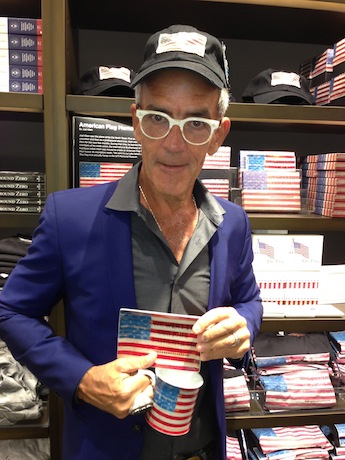 Related Articles
Related Articles

Commemorating Tragedy:
|
 |
N.Y. Local 3 member Joel Klein’s flag, painted on distressed wainscot paneling, was displayed in the local’s motorcycle club meeting room before it found a home at the 9/11 museum and became a template for cups, hats and T-shirts. |
“I thought it was a commercial being shot as I didn’t hear a sound,” he says. His ex-wife said she heard on the radio that a small plane had hit the trade center. “But I knew I saw a full-size jetliner,” says Klein, who, 13 years later, still cringes when he sees planes fly over his small West Village apartment in Manhattan.
After the second plane hit, Klein, who had worked on the World Trade Center as an apprentice, saw the back of the building blow out. He quickly mounted the bicycle which he had taken to work and headed down the West Side Highway toward the trade center. “The image I remember is seeing people running one way and firemen running into the building [ruins],” says Klein, who had been scheduled to work splicing fiber optic cable in a nearby manhole.
By the time he arrived, the World Trade Center had toppled. That afternoon, a stranger threw Klein a set of keys for a flat-bed truck to take into the chaos to help the volunteers. He couldn’t get past the military and state police checkpoint. Neither could truckloads of ironworkers and others who wanted to help save lives. Klein ended up sleeping near the site and offered to assist Salvation Army volunteers the following day. “But there were no people to help,” he says.
Klein worked at Ground Zero for three months for a contractor whose main client was AT&T, one of the companies whose infrastructure was destroyed in the explosions.
Three of the 17 Local 3 members killed on 9/11 were in Klein’s apprenticeship class and one was a high school classmate. Four members of Local 1212 also perished.
“I went to the funerals, but wanted to do more,” he said. So, two years later, as the trade center was being rebuilt and a museum and memorial were rising, he constructed five flags out of wood and a special one to commemorate his fellow Local 3 members who died.
Klein says he’s always been moved by the beauty of the nation’s flag and the sacrifice of those who have fought in its wars.
Eight feet long and four feet wide, the flags, painted on distressed wainscot paneling, carried 17 stars for each union member who died in the carnage. On the flag, constructed in a friend’s studio, he inscribed, “We Went to our Jobs, Fathers and Sons.”
Klein’s original plan was for one of the flags to be placed inside Local 3’s union hall. It was too large, so he ended up convincing the local’s motorcycle club, of which he is a member, to place it in the club’s meeting room in the hall’s basement. And there it stayed until he contacted curators of the 9/11 memorial and museum, built by Local 3 and the N.Y. building trades, and asked if they had a place for it.
Today, Klein’s flag is not only prominently displayed inside the memorial and viewed by thousands of visitors each week. His flag’s image has been imprinted on cups, T-shirts and hats sold at the museum.
Every Sept. 11 since the memorial’s construction, rescue workers, including Klein, have been invited to gather there. He says he is moved by their tears.
Klein says he stays busy since his retirement nine years ago. A longtime balloon twister, he was invited to the White House a few years back on July 4 to participate in a Wounded Warriors benefit. And he’s written a couple of musicals and plays.
He is still amused by the irony of having friends and relatives make fun of him for his “cumbersome” flags that ended up making their way into a historic landmark. And he still thinks about the cooperation and camaraderie that followed the tragedy of 9/11.
“I’m 64 years old,” says Klein. “In a strange way, I related the support that came from all over the world to help after 9/11 to Woodstock. I got a sense that an unbelievable change was happening in the world.”
![]()